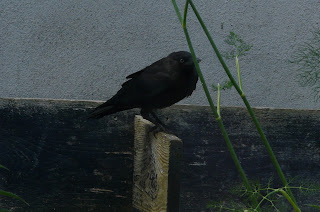Sometimes I feel like a Crèches Supervisor. Don’t you get that feeling that all those hardworking parents sometimes bring their offspring into your garden where they drop them off before leaving for a spot of R&R and perhaps a dinner for two? By putting out food for those silly little uns you have automatically offered to take care of them while the parents are busy elsewhere.
As soon as the food has been tasted and they have gorged themselves on treats like peanutcake {every youngster’s favourite in this garden} seeds or whatever is on offer, it is playtime and the play frames are tested out. My birds love the swing; they will see how many birds they can add onto the one swing, before either the chain breaks or one will fall off because it is bending over too much. When the Sparrows have gathered three birds onto the one swing, they are getting anxious, because it really starts to bend over quite a lot. Looking at each other, they will try and hold on as long as possible before the one on the outside eventually hears the ringing in its ear and is starting to see stars in broad daylight. He or she then realizes that it is time to move somewhere safe. And flying off does not mean he is a sissy, oh no. Far from it. He just likes the fact that by letting go of the swing he has left the others in peril. Because as soon as its feet release their hold onto the swing, it will want to return to its natural position, which is upright and not bend over. As soon as the swing bounces back, the ones left behind on the swing are in a difficult position; is their hold strong enough to stay on the swing, or had they lost their tight grip when sibling departed? Perhaps he had relaxed their grip in a moment of distraction, if so, that bird will be jostled into the air.
Now that another weight has left the swing, the same will happen to the swing’s next victim. He, sitting closest to the roots and thus the bottom of the swing, thought he’d be safest of the lot, as he would be in most circumstances. However he too will now start to see a few tiny stars, dividing into more and more little astral bodies, floating in front of his eyes. Also, he has to be careful to keep that yummy peanut cake in his stomach, otherwise Mum might start feeding him plain old seeds, and no, we don’t want to happen now, do we? It is OK for adult birds to feed on seeds, and he will left with no option to forage for these once he has left home and finds his own, but until then… Come to think of it, where is Mum? Have they all left while we were having fun? OK then, I’d best take advantage of it, now that all the others have left the planter and the peanut cake! I’ll have to start feeding myself one day, and perhaps this is my day…
The Swing in our garden is the Fennel; her vertical stalks is loved y the birds and these not only provide them with a climbing frame and swing, it is also a great vantage point for getting to know your neighbours. In winter, the hollow stems of the Fennel will also provide the Tit species with insects hiding inside it. I’ve often seen the Blue and Coal Tits feed on these while they are waiting for a spot on the peanutfeeder.
Miss Fennel is now looking twice her size at the bottom, where the fronds obscure birds queuing on the shelving behind it, where, like on the Fennel, wall and the cage, birds congregate to have a chat, chew on what they have collected in the planter, or look out for any sign of danger. The wall is also used as a race track for youngsters and adults alike, the Sparrows, Chaffinches and Jackdaws run regularly across from left to right.
And I have also seen the Dunnock use this for that reason, when one day it had to make a hasty retreat from Jackdaws.
Often it is the cage where new birds will land, have a look into the garden, and smell whatever is on offer. Yes, I strongly believe that they “smell it out” besides their sight which is excellent to say the least. But sight and smell I will leave for the next post.
Today I had my Wren visit me again. Jenny only comes now and then, mostly staying underneath the shelf where it will search for Insects in or on the wood. Therefore, it is very hard to get a picture opportunity, and my first photo of her was when she had picked up a large green Caterpillar from my garden. Today’s pictures did not turn out as good as those back in spring. Perhaps also because it was very dull this morning at 9am.
Use of the Swinging Fennel,



Learning to watch for signs of danger while cousins play,

Being thrown in the air from Fennel on the way upright,

Some of my Chaffinches



My Jenny Wren


Juvenile Robin

Great Tit enjoying peanutcake

Magpies, making a racket whilst raiding the foodtray


Hooded Crow too, will join Rooks, Jackdaws and Magpies, in their efforts to get the best of the lot











































.JPG)

